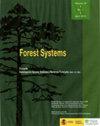Economic and environmental assessment of a multifunctional poplar plantation for roundwood and wood chip production in Spain
IF 0.7
4区 农林科学
Q3 FORESTRY
引用次数: 1
Abstract
Aim of study: To analyze the environmental and economic performance of a multifunctional poplar plantation (MPP), which was managed to produce timber for sawn wood and chips for bioenergy. Area of study: The plantation was located in Southern Spain producing roundwood and woodchips (from tops and branches). Material and methods: The life cycle assessment (LCA) methodology was chosen to perform the environmental impact assessment from a cradle-to-gate perspective. Capital goods, including machinery-manufacturing processes, were included. One oven dry tonne (odt) of forest biomass was chosen as functional unit. The economic analysis was performed using present costs and common indicators: net present value (NPV) and internal rate of return (IRR). Main results: The harvest operations are the most environmental impacting subsystem and cultivation the costliest. Chipping was the process contributing the most to the environmental burden. The use of fertilizers, within the cultivation subsystem, had a notable impact on certain midpoint categories. In terms of climate change potential, 1 odt of delivered wood chips generated 64.1 kg CO2-eq. When considering the whole system (including the roundwood fraction), this value was 45.2 kg CO2-eq odt-1. MPP was hardly profitable with land rental and irrigation being the most expensive items. NPV, including harvesting and transport subsystems, was 1,582 € ha-1, while IRR reached 6.3%. Research highlights: Our results allow to identify the costliest operations and those with the greatest impact to improve the system. Finally, these figures can be compared with other crop alternatives such us poplar short rotation coppice (SRC).西班牙生产圆木和木片的多功能杨树人工林的经济和环境评价
研究目的:分析多功能杨树人工林(MPP)的环境和经济效益,该人工林生产锯材用木材和生物能源用木屑。研究区域:种植园位于西班牙南部,生产圆木和木片(从顶部和树枝)。材料和方法:选择生命周期评估(LCA)方法从摇篮到大门的角度进行环境影响评估。包括机械制造过程在内的资本货物也包括在内。选择一个烘干吨(odt)的森林生物量作为功能单元。经济分析使用了当前成本和常见指标:净现值(NPV)和内部收益率(IRR)。主要结果:收获作业是对环境影响最大的子系统,种植成本最高。削片是造成环境负担最大的过程。在种植子系统内使用化肥对某些中点类别产生了显著影响。就气候变化潜力而言,交付的1 odt木屑产生了64.1公斤二氧化碳当量。当考虑整个系统(包括圆木部分)时,该值为45.2 kg CO2当量odt-1。MPP几乎没有盈利,土地租赁和灌溉是最昂贵的项目。NPV,包括收割和运输子系统,为1582€ha-1,而内部收益率达到6.3%。研究强调:我们的结果可以确定成本最高的运营和对改善系统影响最大的运营。最后,这些数字可以与其他作物替代品进行比较,如白杨短轮伐矮林(SRC)。
本文章由计算机程序翻译,如有差异,请以英文原文为准。
求助全文
约1分钟内获得全文
求助全文
来源期刊

Forest Systems
FORESTRY-
CiteScore
1.40
自引率
14.30%
发文量
30
审稿时长
6-12 weeks
期刊介绍:
Forest Systems is an international peer-reviewed journal. The main aim of Forest Systems is to integrate multidisciplinary research with forest management in complex systems with different social and ecological background
 求助内容:
求助内容: 应助结果提醒方式:
应助结果提醒方式:


